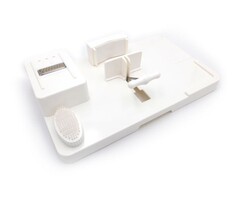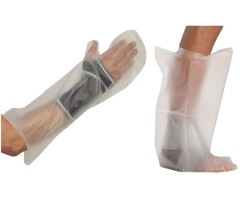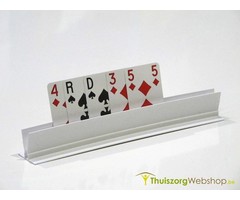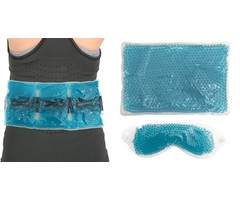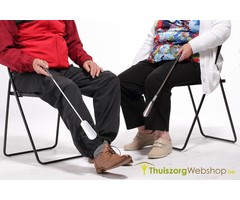
Pain or pain: tools that heal or prevent this
There are different types of arm pain.
For example, you may suffer from tingling or numbness in the arms, a mouse arm (RSI), a tennis arm or a wave arm. You can also have muscle pain in your arms.
Tingling or numbness in the arms can be caused by a number of things. So you can sometimes wake up with a 'sleeping' arm, because your sleeping position limits the circulation of your arm. If you put your arm down, the blood circulation will start again and you will get tingling. In addition, you may suffer from numbness in your arms if you have burns, since they can affect the nerves. Deep cuts can also cause numbness in this way.
You can get a mouse arm by handling a wrong posture while working behind the computer. A mouse arm is a form of RSI, which stands for Repetitive Strain Injury, which basically means that you have performed a certain action in a wrong way. For example, if you click a mouse with a mouse in a wrong position, you may suffer from RSI in the arms, neck or shoulders. RSI is a condition that gradually develops, but that can cause severe symptoms. Ensure a good working posture and a good seat at the right height to prevent a mouse arm.
A tennis arm , also called tennis elbow, is a form of arm pain. The pain locates around the elbow and the spot where the forearm muscles are on the outer elbow nipple is irritated. When you pinch your hand or bend your wrist back, it hurts. The same is true when turning your forearm. In principle, a tennis elbow changes itself and you have to be especially patient. It can take months for a tennis elbow to pass.
The wave arm is a form of arm pain in your forearm. The pain is located on the spot where the forearm muscles are stuck to the inner elbow nipple and it hurts when you pinch your hand, bend your wrist forward or your forearm turns inward. In principle, a wave arm also passes automatically, but this can take months.
Armpijn can also be caused by muscle pain . You get muscle pain, for example, by exercising or by lifting. Imagine playing a lot of tennis or badminton, this can cause muscle pain.
There are different types of arm pain.
For example, you may suffer from tingling or numbness in the arms, a mouse arm (RSI), a tennis arm or a wave arm. You can also have muscle pain in your arms.
Tingling or numbness in the arms can be caused by a number of things. So you can sometimes wake up with a 'sleeping' arm, because your sleeping position limits the circulation of your arm. If you put your arm down, the blood circulation will start again and you will get tingling. In addition, you may suffer from numbness in your arms if you have burns, since they can affect the nerves. Deep cuts can also cause numbness in this way.
You can get a mouse arm by handling a wrong posture while working behind the computer. A mouse arm is a form of RSI, which stands for Repetitive Strain Injury, which basically means that you have performed a certain action in a wrong way. For example, if you click a mouse with a mouse in a wrong position, you may suffer from RSI in the arms, neck or shoulders. RSI is a condition that gradually develops, but that can cause severe symptoms. Ensure a good working posture and a good seat at the right height to prevent a mouse arm.
A tennis arm , also called tennis elbow, is a form of arm pain. The pain locates around the elbow and the spot where the forearm muscles are on the outer elbow nipple is irritated. When you pinch your hand or bend your wrist back, it hurts. The same is true when turning your forearm. In principle, a tennis elbow changes itself and you have to be especially patient. It can take months for a tennis elbow to pass.
The wave arm is a form of arm pain in your forearm. The pain is located on the spot where the forearm muscles are stuck to the inner elbow nipple and it hurts when you pinch your hand, bend your wrist forward or your forearm turns inward. In principle, a wave arm also passes automatically, but this can take months.
Armpijn can also be caused by muscle pain . You get muscle pain, for example, by exercising or by lifting. Imagine playing a lot of tennis or badminton, this can cause muscle pain.
There are different types of arm pain.
For example, you may suffer from tingling or numbness in the arms, a mouse arm (RSI), a tennis arm or a wave arm. You can also have muscle pain in your arms.
Tingling or numbness in the arms can be caused by a number of things. So you can sometimes wake up with a 'sleeping' arm, because your sleeping position limits the circulation of your arm. If you put your arm down, the blood circulation will start again and you will get tingling. In addition, you may suffer from numbness in your arms if you have burns, since they can affect the nerves. Deep cuts can also cause numbness in this way.
You can get a mouse arm by handling a wrong posture while working behind the computer. A mouse arm is a form of RSI, which stands for Repetitive Strain Injury, which basically means that you have performed a certain action in a wrong way. For example, if you click a mouse with a mouse in a wrong position, you may suffer from RSI in the arms, neck or shoulders. RSI is a condition that gradually develops, but that can cause severe symptoms. Ensure a good working posture and a good seat at the right height to prevent a mouse arm.
A tennis arm , also called tennis elbow, is a form of arm pain. The pain locates around the elbow and the spot where the forearm muscles are on the outer elbow nipple is irritated. When you pinch your hand or bend your wrist back, it hurts. The same is true when turning your forearm. In principle, a tennis elbow changes itself and you have to be especially patient. It can take months for a tennis elbow to pass.
The wave arm is a form of arm pain in your forearm. The pain is located on the spot where the forearm muscles are stuck to the inner elbow nipple and it hurts when you pinch your hand, bend your wrist forward or your forearm turns inward. In principle, a wave arm also passes automatically, but this can take months.
Armpijn can also be caused by muscle pain . You get muscle pain, for example, by exercising or by lifting. Imagine playing a lot of tennis or badminton, this can cause muscle pain.






